Standard [CURRENT]
ASTM E 1211/E 1211M:2017
Standard Practice for Leak Detection and Location Using Surface-Mounted Acoustic Emission Sensors
- German title
- Richtlinie über das Aufsuchen und die Ortung von Undichtheiten mit Oberflächen-Schallwandlern
- Publication date
- 2017
- Original language
- English
- Pages
- 5
- Publication date
- 2017
- Original language
- English
- Pages
- 5
Product information on this site:
Quick delivery via download or delivery service
Buy securely with a credit card or pay upon receipt of invoice
All transactions are encrypted
Short description
1.1 This practice describes a passive method for detecting and locating the steady state source of gas and liquid leaking out of a pressurized system. The method employs surface-mounted acoustic emission sensors (for non-contact sensors see Test Method E1002 ), or sensors attached to the system via acoustic waveguides (for additional information, see Terminology E1316 ), and may be used for continuous in-service monitoring and hydrotest monitoring of piping and pressure vessel systems. High sensitivities may be achieved, although the values obtainable depend on sensor spacing, background noise level, system pressure, and type of leak. 1.2 Units- The values stated in either SI units or inch-pound units are to be regarded as standard. The values stated in each system may not be exact equivalents; therefore, each system shall be used independently of the other. Combining values from the two systems may result in non-conformance with the standards. 1.3 This standard does not purport to address all of the safety concerns, if any, associated with its use. It is the responsibility of the user of this standard to establish appropriate safety and health practices and determine the applicability of regulatory limitations prior to use. 1.4 This international standard was developed in accordance with internationally recognized principles on standardization established in the Decision on Principles for the Development of International Standards, Guides and Recommendations issued by the World Trade Organization Technical Barriers to Trade (TBT) Committee.
Also available in
Loading recommended items...
Loading recommended items...
Loading recommended items...

